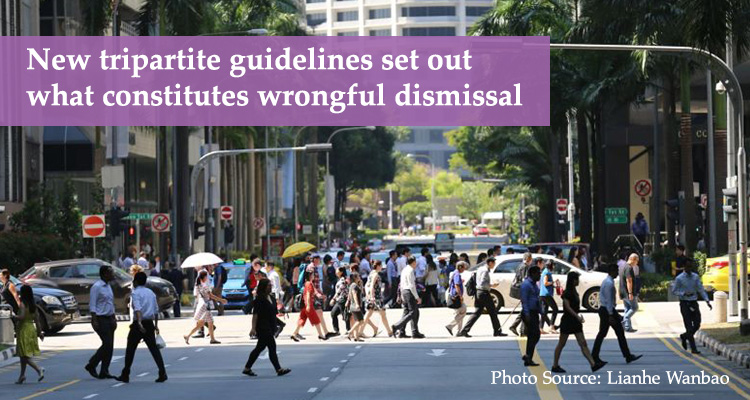New tripartite guidelines set out what constitutes wrongful dismissal

[Source: https://www.straitstimes.com/business/new-tripartite-guidelines-set-out-what-constitutes-wrongful-dismissal]
SINGAPORE – Workers and employers can now refer to clear examples of what constitutes wrongful dismissal, should any dispute arise.
New tripartite guidelines published on Monday (April 1) set out illustrations of wrongful dismissal that include discrimination, avoiding benefits payment, punishing an employee for exercising an employment right, and false reasons.
For example, the guidelines make it clear that it would be wrong to dismiss with notice an employee of three years who informed the company of her pregnancy, without paying any maternity benefits and without any legitimate reason provided for the dismissal.
As for discrimination, the guidelines state that even if notice is given, it would be wrong to dismiss an employee after his employer has made numerous discriminatory remarks about his race and said he prefers to hire someone of another race.
The guidelines also set out examples of dismissals that are not wrongful, such as on the grounds of poor performance, misconduct and redundancy.
Developed by the Ministry of Manpower (MOM), National Trades Union Congress (NTUC) and Singapore National Employers Federation (SNEF), the guidelines follow changes to the Employment Act, which now allows all employees to file claims against their employers for wrongful dismissal.
ADVERTISING
After the monthly salary cap of $4,500 was removed, more managers and executives are now covered under the core provisions of the law, which include statutory protection against wrongful dismissal.
This is among changes that take effect on Monday, after being passed in Parliament in November 2018.
The Employment Claims Tribunal will now hear wrongful dismissal claims, instead of the MOM.
Workers covered under the Employment Act can file wrongful dismissal claims at the tribunal from April 15, but only if mediation is unsuccessful.
They must first undergo mediation at the Tripartite Alliance for Dispute Management (TADM) under the Tripartite Mediation Framework, which has been expanded to cover wrongful dismissal claims.
The new guidelines provide several other illustrations of wrongful dismissal, based on cases MOM has heard or received feedback on.
In one example, a worker who earns less than $4,500 a month was dismissed with notice after declining his employer’s request to work overtime, as he wanted to take care of his infant child.
The employer told the worker that he could not afford to have someone who prioritises his care-giving duties over working overtime.
Another example is an employer who dismissed a staff member after finding out that he had filed a request for mediation with TADM because he was owed three months’ salary.
In these cases, the employers are punishing the employees for exercising their employment rights.
When reasons are given, it can be deemed a wrongful dismissal if the reasons are proven to be false.
In one illustration, a worker was dismissed after being told the company was restructuring and his job would no longer exist.
But he later learnt that the former employer had recruited someone else to fill his post.
The guidelines state that the employer did not need to provide a reason for the dismissal with notice but did provide one, which turned out to be false. The dismissal was therefore wrongful.
For dismissals that are not wrongful, the employer needs to show that there was misconduct – such as dishonest conduct at work, insubordination or bringing the organisation into disrepute – or poor performance.
Misconduct is the only legitimate reason for dismissal without notice.
In general, when notice is given, dismissals are presumed not to be wrongful as both employees and employers have a right to terminate employment with notice, based on the contract.
Redundancy is also a legitimate reason for dismissing an employee with notice. The guidelines state that redundancy occurs when there is excess manpower, the company is undergoing restructuring, the old job no longer exists, or the worker’s job scope has changed.
Mr Lee Pak Sing, MOM’s divisional director for the workplace policy and strategy division, said in a statement that the guidelines reflect the consensus reached between employers and unions.
He added that the guidelines will help TADM and the Employment Claims Tribunal in managing wrongful dismissal claims, now that hearing such claims is no longer under the ministry’s purview.
NTUC assistant secretary-general Cham Hui Fong said the guidelines will help provide clarity to employees on the grounds on which they can appeal if they feel that they have been wrongfully dismissed.
SNEF executive director Koh Juan Kiat said the organisation welcomes the clarity as well, “as it will help prevent frivolous claims from employees, minimise workplace disputes as well as reduce unproductive and disruptive discourse”.








